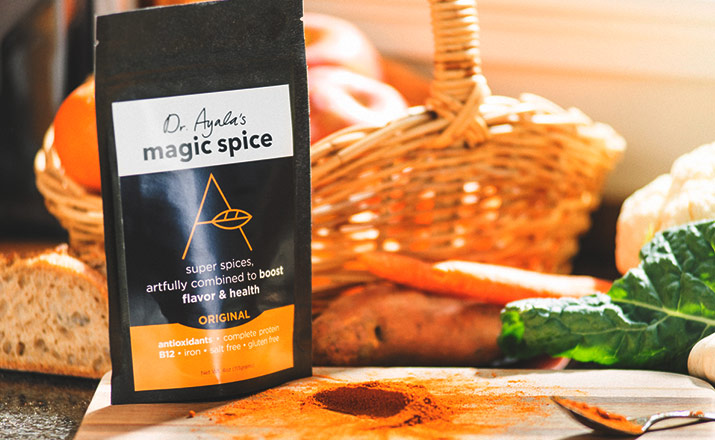
Here's Why You Need to Cook More

We can endlessly debate which diet is the healthiest, but there’s one diet pattern that all experts agree is really bad for you: the ultra processed diet.
Unfortunately, the ultra processed diet is also super popular: Soft drinks, French fries, processed meats, cookies, sweetened cereals and salty snacks, make up more than half of the caloric intake of what Americans eat.
The explosion of highly processed food has been clearly linked to rising obesity rates. Is it that ultra processed foods play tricks with our satiety signals? Does their lab-assisted tastiness make us overeat? Is their fiber-free state the issue?
Association, however, doesn’t prove cause, and that’s why a new randomized trial study, published in Cell Metabolism, is so interesting.
The study's volunteers lived in the NIH Clinical Center for about a month, during which they were randomly assigned to two weeks on an ultra-processed diet, two weeks on an unprocessed diet, or the reverse order of regimes. Both diets were matched for total calories, energy density, carbs, protein and fat, fiber (fiber was added to drinks in the ultra-processed diet,) sugars and salt. The volunteers were instructed to eat as much or as little as they wanted.
The unprocessed dishes required more prep, that’s for sure, but weren’t an exceptionally wholesome regimen: no brown rice or whole-wheat pasta, just real food made from basic ingredients. So while an ultra processed dinner may contain chicken salad sandwich (made of canned chicken, Heinz pickle relish, Hellmann’s mayonnaise on white bread) and canned peaches, the unprocessed version would include a beef tender roast with a rice pilaf made of basmati rice, garlic, onions, sweet peppers and olive oil served with a steamed broccoli salad with balsamic vinaigrette and orange slices.
And the results: on the ultra processed diet, people ate an average of 500 calories more than they did on an unprocessed diet daily.
That led to about 2 pounds of weight gain in the 2 weeks on the ultra-processed diet.
On the unprocessed diet the participants lost about 2 pounds.
The participants did not report more familiarity or preference for either diet. They did however eat the highly processed meals faster.
This small study suggests that eliminating highly processed foods or limiting their consumption may help you control weight gain – even when you’re not trying to eat less.
It suggests that there’s something about ultra-processed food that makes people overeat and gain weight.
It’s not just weight gain
Ultra processed foods are light on the wallet, but carry a heavy cost. We’re paying for this inexpensive food with our weightiness and with our health.
A recent large study found a 10 percent increase in ultra-processed food was associated with a 10 percent higher risk of overall cancer and breast cancer and a newly published study in in Public Health Nutrition following 12,000 Americans for more than 20 years found that eating more ultra-processed food was associated with a 30 percent higher risk of dying.
These studies, and the controlled study mentioned above, don’t point at the mechanism of harm. Regardless of the mechanism, the highly processed diet is probably one of the worst ways one can eat. Ultra-processed foods have low nutritional value, they contain chemicals – stuff that isn’t food – and are made to please and manipulate our reward system. Food chemists balance sugar, fat, salt, flavorings, mouthfeel and crunch for maximum pleasure and ease of eating.
Cook more, reduce ultra-processed
The best way to cut ultra-processed food is to cook more; meals needn't be fussy, and simple dishes can be delicious, inexpensive, and once rehearsed not terribly time consuming.
For the foods you purchase watch out and target ultra-processed foods for reduction. Here are my tips for spotting ultra-processed foods:
By group:
Fast food, most fully prepared and frozen meals, many of the mass produced chips, crackers, and highly sweetened cereals, cured meats (ham, salami, bacon, some sausages.)
Individually; read the ingredient list for these clues:
Artificial ingredients: If you can’t pronounce or identify the ingredients they’re probably chemicals, added for flavor, color, texture or preservation.
Sugars and sweeteners in large amounts: (including sugar’s many equivalents, such as dextrose, evaporated cane juice etc.): Look for the “added sugar” quantity or look for sugars among top 3 ingredients of non-dessert foods. Foods with lots of added sugar are the hallmark of highly processed food, and the worst offenders are sugary drinks. High-fructose corn syrup is the symbol of high processing and industrialized food. Desserts and treats are made with plenty of sugar and sweeteners, whether highly processed or made from scratch, and those are best eaten in moderation, regardless of processing level.
Dr. Ayala
In Same Category
- Diet affects vulnerability to Covid-19
- To Fight Inflammation Try Your Spice Rack
- Make Vegetables Sexy
- It Isn’t Meat, but Is It Delivering on Plant-Based?
- Activating Brown Fat – and Your Metabolism – with Turmeric, Coffee and Other Goodies
- Here's Why You Need to Cook More
- Top Healthy Food Trends for 2019
- An Easy, Proven Trick for Eating Healthier
- 12 Delicious Cooking Tips That Will Set You Free From The Salt Trap
- Smart Eating for a Successful School Year
- Fitness, Mindfulness and Healthy Eating – There’s an App for That
- Sustainable Summer: Greening your BBQ
- How to Eat Healthy in College and Avoid Weight Gain on Cafeteria Food
- Want Kids to Eat More Veggies? Season Them Up!
- All You Ever Wanted to Know About Nutritional Yeast and Its Health Benefits
- Falling in Love with Kickstarter
- Fighting Inflammation with Spices
- 3 Things Plant-Based Eaters Should Watch For
- Turmeric Absorption and Tips to Enhance Its Activity
- BEFORE & AFTER: Roasted Sweet Potatoes
- BEFORE & AFTER: Baked Potato Wedges
- BEFORE & AFTER: Roasted Cauliflower
Related by Tags
- Here's Why You Need to Cook More
- Top Healthy Food Trends for 2019
- An Easy, Proven Trick for Eating Healthier
- Fitness, Mindfulness and Healthy Eating – There’s an App for That
- Sustainable Summer: Greening your BBQ
- How to Eat Healthy in College and Avoid Weight Gain on Cafeteria Food
- 3 Things Plant-Based Eaters Should Watch For
